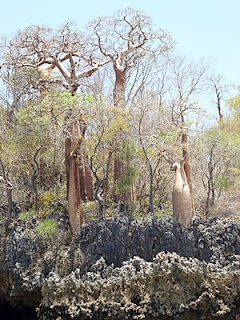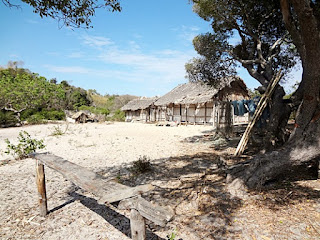A cropped shot of the zoomed in photo of the red and white sculptured sandstone cliffs on the way to Majunga/Mahajanga. They were gorgeous and I really wished I had a big zoom on a fancy camera for these.
But you can get the idea. Some cliffs were white sandstone.
Another view of some red and white cliffs. They remind me of the Anazazi cliff dwelling sites.

Pretty amazing natural formations, I think. Looking through the binoculars, they looked stunning!
I would've loved to stop and explore the area, but there was no bay to anchor in and we were pushed for time to reach a safe anchorage in the daylight.
One last view of another section of coastline.
In Majunga, there were dozens of the local dhows that went out in the morning and returned in the afternoon with the alternating winds. We were in the center of the parade most of the day. Great entertainment to watch these guys sail these boats.
A bigger dhow or gullet with three sails. He went into the small craft harbor that we were anchored outside of and the little guys go further down the bay and sit on the mud when the tide goes out.
Even the big boats have some old sails that always seem to need mending. But they keep on sailing.
Some need a bit more mending than others! I wonder how they even sail without shredding. Note the guy way out on the outrigger to keep the boat flat in the water. Probably a nice place to ride back on, too.
A big intersection in Majunga. The sticks on the roof of the building are scaffolding for work being done on the roof. The town is old but not much of it is in use. Notice there is no traffic really. Lots of abandoned buildings here.
These man-powered rickshaws are still used to transport goods around town.
A nice old building that has been taken car of and is now in use as a hotel, but not many people here visiting just now.
Jason walking by an old building that hasn't been taken care of or restored.
Jason on a cannon in a park with a monument.
An old Citroen car sitting waiting to be repaired.
Another old building that has been abandoned in Mahajanga.
And another that has been kept as a hotel.
Karen and a spiny baobab planted outside a hotel.
The colored rickshaws are for carrying people.
The local boat harbor at low tide. All the boats just sit on the mud until the tide comes back in . Very colorful boats and they seemed to string lines across the harbor so we had to be very careful coming in with the dinghy not to catch one of them as we crossed over it.
With the low tide, everyone sits in the mud. We could only use the dinghy landing space for a couple of hours before and after high tide each day. Otherwise, we had to step into the muck and trash at the edge and dodge concrete blocks and rebar sticking out of the shallows with our dinghy motor. And since the water was orange with mud, that could be tricky.
Bundles of raffia hanging on a fence to dry in the sun.
A bundle of raffia tied up to dry on the shore. They use the stuff to weave and make many handicrafts like baskets and cute little animals.
The dinghy sitting on the landing. A boat boy (one recommended by other cruisers) would help us drag the boat up and back to/from the water and he expected payment for his help and for watching over our dinghies. We gave him ten DVDs and a case to hold them and he still wanted money to eat. All the dinghies on our last day discovered their gasoline had been stolen from the dinghies while they were on shore and we decided not to go back in and pay the guy. He obviously was part of the theft event and we think his friend acted as lookout to make sure no yachties were coming down the road. We found him sleeping in the shade of the big boat one day. Since the dinghies were well hidden from sight behind this boat on the left, it was an easy opportunistic theft. The pilfering through the dinghy compartments was evident in another dink and we decided we were leaving the next day and just pulled ours out of the water to ready it for passage. Too bad the guys we paid to watch them were also thieves. We'd been warned of thefts and beatings experienced by other yachts here earlier, but we'd felt pretty safe here. It's an interesting town with some great bargains on really excellent souvenirs, but we used up all our Ariary money and are heading south to await a weather window to head to South Africa.
While the men took care of the business with the Port Captain/Harbor Master and got us new clearance papers, the women went shopping and photo taking. I loved the intricate carving down the center of the door and the molding on this entry way.
Karen next to a bale of raffia coming or going on one of the boats.The pile of raffia bales and the boats in harbor.
Notice the tilt with the boats sitting in the mud at low tide. There is actually a man under that bale of raffia coming off the boat int he center. We had a beer crate like the ones shown here, but that too was stolen from our dinghy on our last day in town.
Coconut vendors across from the boats.
These are crates of tomatoes going to the market vendors. No wonder some of them get smashed. But I did buy nice tomatoes at the market this day.
A lady making and selling charcoal just across the street from the harbor.
An old abandoned building from 1917, with small children playing by the wooden rickshaws.
Ever seen a cement toilet before?? They had cement sinks, too.
A man grinding beef into hamburger behind a fruit stand in the market. Note the flies on the cabbage.
One of the beef butcher stands in the market.
A colorful souvenir stand with lots of woven and wrapped raffia items. The animals are made from raffia wrapped many times around to form layers.
More tough, muscle-bound guys grinding meat into hamburger. They were showing off with how fast they could turn the grinder.
These women headed towards us in the middle of the street in front of one of the big supermarkets here in Mahajanga. They carried bananas, mangoes, pineapples and melons in the tubs on their heads. We bought a bit from them before moving on.
The 'makeup' on their faces may indicate which tribe they are from. It may also be a way to keep the sun off.
Once we were done, they put their wares back on their heads and crossed the road to carry on with their selling.
A sunken ship at the wharf in Mahajanga. We think one of its lines must've broken when the wind blew and it just rolled at the wharf, tipped and sunk. Men were working to cut it up while we were there. We had to move out of the protection of the breakwater when a cargo ship came in so they could use tugs and barges to offload the containers of stuff. They didn't want the barges weaving between yachts, so we all moved out of the way.










































































































